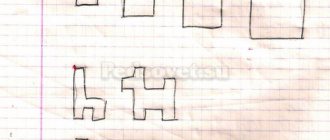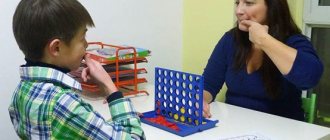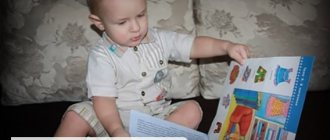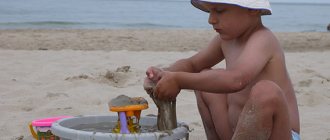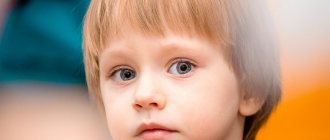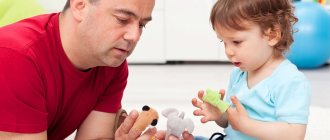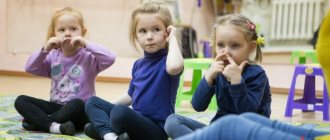Good afternoon, dear readers! When our baby was born, we witnessed her new achievements with great interest. Most of all there was the anticipation of the first words!
But, did you know that it is recommended to develop sound pronunciation skills from the very cradle? Great work. But he's worth it.
What activities are the most effective? I scoured the entire Internet in search of an answer, now I hasten to share with you.
Where to begin
A baby celebrates its birthday up to 12 times before it is one year old. After all, every month is a real holiday for parents! It's about the achievements of the little creature. In the first year of life, a little person learns a lot. Our duty, of course, is to help according to all the rules. The main thing is to organize exercises in a playful way. Well, you understand that the child needs to be interested!
From the age of two months we massaged our fingers. They just warmed up one by one. A little later, such gymnastics can be diluted with jokes and funny conversations.
And from the age of 8 months, I actively commented on what was happening to the baby. Especially on a walk. She simply and naturally talked about trees, giving characteristics regarding height, color of leaves, etc. Animals, which can be seen in large numbers on the street, have a very beneficial effect. And at 8 months I heard the long-awaited “Kh”, which in our alien language meant “cat”. Talk about everything! This is how verbal memory develops and preparation for pronouncing the first words occurs.
Cost of speech therapist-defectologist services:
| Service | Price |
| Initial paid appointment with a children's speech therapist (diagnosis and consultation) | 2,500 rub. |
| One lesson | 2,000 rub. (40 min. - 1 hour) |
| Lesson in a dyad or mini-group | 1,800 rub. (50 min.) |
| One lesson in combination with Forbrain | 2,400 rub. (40 min.) |
A speech pathologist-defectologist provides paid services in each of the four departments of our Center in Moscow, prices are indicated above. Every day from 10-00 to 18-30.
Features of speech therapy at 2 - 3 years
If up to the age of one year the parents did not require any special knowledge of the child’s speech abilities, then by the age of two the task becomes more complicated. Speech therapy classes for children 2 - 3 years old are necessary for timely assistance in overcoming the verbal barrier. Unfortunately, not all children complete the new level in a timely manner. Children with speech impairments definitely need a competent specialist and support from their family. I will highlight the main points.
- The tasks are based on reproducing an adult’s movements, gestures, and subsequently sound pronunciation.
At such a tender age, it is impossible to verbally explain to a child what they want from him. But kids love to repeat. So play with them a fun game involving gesturing. An example would be “Magpie - magpie”, “Goat - horned”. First, show slowly, play, then ask to repeat.
- Carry out any educational processes in a playful way.
After all, this is exactly what curious researchers need. So you will be interested. But remember that children cannot pay attention to one activity for more than 20 minutes. Be able to quickly redirect your tomboy's attention.
- Make emotional contact.
Show genuine interest in spending time together. The tiny creature is extremely vulnerable and senses any notes in the adult’s change of mood. The more you are involved in the essence of the task, the happier the baby will be.
- What about the awards?
Don't forget to reward efforts. This will cause additional motivation and create a favorable background in communication. It so happened that our child learned about candy only at the age of 3. And I conducted active training for speech development with her at 2.5. She encouraged her with her favorite toys, and fruit purees replaced sweets. What I mean is that there is no need to overdo it with awards! Remember about the unstable digestive tract of the toddler.
Reasons for rejection
A child becomes non-verbal as a result of not only psychological disorders. The social environment plays an important role in the development of speech. If parents do not talk to the baby from birth, do not spend time together playing games, and the baby is left alone with himself in the sandbox during a walk, RDD may occur. It is more difficult to learn speaking if there is no communication with other children, people other than mom, dad, and grandmothers. It is easier to teach speech when the child enjoys playing together. If parents have chosen the wrong, uninteresting development program, the baby may be lazy to study and not be active.
Psychologists say that speech delay often occurs as a result of the child’s character traits, which is not a negative factor. Parents should not force a child who is shy and timid to speak. A one-year-old boy or girl can be sociable and active, play with other people and children, and upon reaching the age of two, become modest and unsociable. This is due to age characteristics, the crisis of 3 years of age, when the baby begins to divide adults into “us” and “strangers”. Heredity plays an important role. If mom or dad started speaking late, the child repeats the speech behavior of the parents in 70% of cases.
The provoking factor for the development of mental retardation is the lack of need for speaking. Moms and dads love to fulfill the child’s requests the first time, sometimes the baby doesn’t even say the wish, he points with his finger, “moos.” Parents guess what the baby needs without words and fulfill the request, which is wrong. The child lacks motivation to speak when he is already understood. If the baby points with his finger and does not want to speak, psychologists advise saying: “I don’t understand what you want, tell me,” more often to provoke situations that complicate the child’s activities without language.
Among the pathological causes of FGR are:
- Neurological disorders.
- Somatic pathologies.
Developing general imitation
In the earliest stages of growth, children can play games aimed at reproduction. This is copying the movements of an adult, which help to relax. The tasks train coordination and imagination. Today the little one repeats gestures, and tomorrow - words. Yes, do not forget to accompany such gestures with conversations. When you have a child with general speech underdevelopment (GSD), carrying out activities of this kind is the basis of speech therapy.
The simplest thing we can offer is regular charging. Activity lovers will appreciate this. Just do the gymnastics in a strictly defined sequence. The goal here is for a tiny person to memorize the whole combination. Be sure to comment every time. Children love repetitions. And if you touch on in-depth material, you can use the following fun.
11.Big or small?
Goal: to teach children to correlate the words “big” and “small” with the size of objects. Materials: in this game you can compare any toys and objects; You can use pictures in further work. Progress of the game: When forming the concepts of “big” and “small”, it is useful to teach children to use expressive gestures: “big” - spread your arms to the sides (or simultaneously up and to the sides), “small” - bring your palms closer to each other (or bring your hands closer to each other). index and thumb towards each other). To do this, the speech therapist constantly uses these gestures and encourages children to use them. The names of concepts should be highlighted in speech. Show the children the big and small balls. Look, here's a ball, and here's a ball too. Are the balls the same? No, the balls are different. This ball is big! (the speech therapist shows the appropriate gesture), and this ball is small (the speech therapist shows the appropriate gesture). What kind of ball is this - show me. (the speech therapist encourages the children to show the gesture) That’s right, small. What is this ball? Show! (the speech therapist encourages the children to show a gesture) It is useful to repeat this game using a variety of subject material.
Games with general imitation
And if we talk about in-depth material, then from all the variety of exercises I have highlighted the main ones. My little girl loved these.
- "Birds"
The easiest imitator. The arms must be folded like wings and flapped like a bird. And then go for a run. Any tomboy will be delighted with such fun. Especially when an adult is involved in what is happening! Support your tomboy!
- “Putting the doll to sleep”
In our childhood it was called “Daughters - Mothers”. Give the baby a doll, arrange a sleeping place, a blanket. Ask your assistant to rock this baby to sleep. And when he puts him down, show a sign of silence: bring your index finger to your lips, saying “chi-chi-chi.” Let the baby ask the other dolls to be silent while the baby doll sleeps. If the tiny person already talks a little, explain that this needs to be done in a whisper. In the same manner, you can bathe, dress, and feed your favorite toy.
- "Poetic actions"
You can complicate the task with poetic texts using gestures. Our little one loved the rhyme “The wind blows in our faces.”
The wind is blowing in our faces, (we wave our palms in front of our faces) The tree is swaying! (handles up, tilt left and right) The breeze is getting quieter, quieter, (handles down) The tree is getting higher, higher! (Handles up, jump).
Speech imitation
Now we move on to the next stage, we try to evoke any manifestation of sound pronunciation in the child. The simplest ones, from the mooing of animals to the sounds of transport. That's why it's so important to stop at ordinary moments when walking on the street. Just don’t lisp: “Oh, who woke up?” The baby is not yet familiar with speech at all! He will imitate, but the incorrect perception of words will remain for a long time. Speak correctly if possible, of course. Control yourself in communication.
Well, in order to catch the first “sound signals” from the heir, start with something simple. This includes playing with dolls. Well, then use your imagination! Getting to know any objects that make sounds: vacuum cleaner, refrigerator. You know, my sister specifically showed her son things that required him to pronounce complex letters: “drr, brrr.” But the result is obvious! No pronunciation defects in the future.
Useful tips
Parents should be aware of the following points:
- Practice only when the child is in the mood to play. You should not force your son or daughter to take speech therapy classes.
- Show more patience, encourage your child, don’t scold him, don’t demand immediate correct pronunciation.
- Compose and invent new games according to the scheme of the previous ones, let your favorite children's characters and heroes of games and cartoons appear in your games.
- Do not despair if at first the child complains of fatigue. Gradually, his speech apparatus will become stronger, and correct reproduction will become the norm, a natural process.
Watch another game for speech development in the following video.
Games with speech imitation
You can find a lot of interesting nursery rhymes on the Internet. And I’ll tell you our favorites that we enjoyed doing at home.
- "Dudochka"
Ask the little one to play the pipe. You can buy it in a store, or you can improvise. Be sure to demonstrate how the instrument sounds by saying “doo-doo.” Now it's the little musician's turn. In general, what concerns musical instruments should please the restless person. This is both a drum and a piano.
- "Let's go by car"
Place the baby on your lap, facing you. Start the car, imitating the corresponding sound. You can give an improvised steering wheel. And go! Signal: “bi-bi”!
- "Fun Zoo"
Any restless person will have toy animals in their arsenal. Collect them in a bunch and demonstrate who says what. You can, of course, do this using book pictures as an example, but toy characters are perceived better.
Pure talk
They are also necessary for the development of the baby’s speech. Pure sayings, like poems, should be short and easy to remember:
- “Oh-oh-oh – our cat isn’t so bad.”
- “Uh-uh-uh - our rooster crowed.”
- "Ah-ah-ah - we are standing on our feet."
- “Sha-sha-sha – mom’s noodles turned out delicious.”
- “Shu-shu-shu - I’ll ask daddy.”
- “Shi-shi-shi - how the reeds rustled.”
You can come up with such pure sayings yourself. It all depends on which letters the baby cannot pronounce.
The role of the book
The book serves as an integral attribute in the formation of sound pronunciation. Judge for yourself, the plot, illustrations, and new characters are of interest. Perfectly suitable for use even with varying degrees of severity of OHP. The simplest texts of folk tales are aimed at helping the little one.
Sukhomlinsky also noted:
“Reading books is the path along which a skillful, intelligent, thinking teacher finds the way to a child’s heart.”
You talk, show pictures at the same time, discuss the plot. Start reading when your heir is not talking yet. Believe me, the vocabulary is already being formed. Just read with intonation so that the tomboy wants to reproduce it. Use the easiest nursery rhymes in the initial stages.
Include imitation here. You can assign roles once the script is memorized. Copy a clumsy bear, a bunny, a fox, and the baby will happily copy! Answer questions. Only when the little sly one is already able to pronounce words out loud, but uses gestures to ask for something, do not indulge.
My daughter was one of the first to master the “give” request, before she was a year old. But when I realized that I would still get the item I was interested in, I excluded it from my vocabulary. Don't be lazy! But you can’t demand either. It is important to generate interest.
Book material for classes
Personally, I would recommend reading our classic A.S. Pushkin. It is impossible not to note the colorful palette of these works. How harmoniously the selection of words and phraseological units is used. It is not without reason that adults who want to correct their pronunciation are also advised to read it. It’s easier to formulate this in the initial stages than to correct it later. And besides, this is our language! And who better than the classics could present “the great and mighty” in such colors?
The role of folklore is undeniable. This will also be interesting in the very early stages. But there are children with certain problems or prerequisites. There are specially designed manuals for such people.
- “Development of vocabulary: textbook”, author Plotnikova S.V. Here we describe the features of the baby's vocabulary at each stage of life. And a set of exercises is given for each problem separately. The publication is aimed at helping the little one with the correct pronunciation.
- “Album on speech development”, author V. Volodin. Simple manipulations help the little one develop clear diction. Recommended: 3 to 5 years. This is a very important stage at which the active formation of the speaking apparatus occurs. At 3 years old, a fidget is able to repeat a lot of words. But how he will do this is another question. I have a “Large Album on Speech Development,” which contains 3 books for children (the smallest, 3-6 years old and preschoolers). In short, I'm delighted with it.
- “How to turn a “non-speaking” child into a talker”, authors T.V. Bashinskaya, T.V. Pyatnitsa. This book systematizes practical skills aimed at helping non-speaking babies. The method of participation of fine motor skills in the formation of sound pronunciation is very clearly described.
- “Speech therapy manual for classes with children”, author Bogomolova A.I. The publication contains techniques for restoring damaged sounds. What is unusual here is that the methodology is based on the works of famous authors. Everyone read Agnia Barto, S. Ya Marshak and others in childhood.
- “Speech therapist lessons. Games for speech development." Author Elena Kosinova. I really like this book. It has a huge number of finger games, articulation exercises and lots of tongue twisters.
If you are interested in what other benefits are available, I invite you here.
Arsenal of specialists
The complex of activities of a speech pathologist with children includes onomatopoeic games, logorhythmics (speech exercises with the addition of movements), various games with objects, toys, and special aids. At the same time, a specialist can widely use a wide variety of materials: cards, thematic pictures, children's lotto, dishes, and use different types of activities.
- Fine motor skills are developed by assembling puzzles, mosaics, construction sets, and pyramids; building towers from cubes, painting with finger paints, rolling balls, nuts, ribbed pencils in your palms; doing modeling.
- Visual attention is sharpened with the help of cards, children's lotto, bright toys or pictures.
- Auditory skills are developed by all kinds of children's musical instruments or objects that make different sounds (spoon and glass, plastic bags).
- When carrying out breathing exercises, cotton wool, paper figures (butterflies, birds), soap bubbles, water and cocktail straws are used.
- To develop tactile sensations, objects with surfaces of different properties (metal, wood, fur, satin), finger puppets, and spiked balls are used.
Speech exercises must be carried out in front of a mirror so that the baby can see his movements and correlate them with the movements of the teacher.
We have already talked about what kind of exercises can be carried out in such cases:
- finger exercises and exercises for the development of phonemic hearing are described in detail here (exercises for speech development);
- logorhythmic exercises were discussed in this article;
- articulatory gymnastics for the development of speech and breathing organs were discussed here.
For a child of this age, it is very important to study in a familiar environment. Therefore, if it is not possible to invite a specialist to your home, organize similar classes for him at home. This way he will consolidate the acquired skills and get the feeling of an unfamiliar home, but of familiar actions. And this is also stability.
Impact of fine motor skills
There is probably no person who has not heard about the influence of motor skills on the brain. The mechanism is simple, an impulse is given, the brain works. With children this should be done in a playful way. It is necessary to pull something out, assemble a large mosaic, etc.
I will tell you the most accessible techniques that I used for my daughter at 1.8 years old.
- Find what's at the bottom
Take 2 bowls, pour beans into one and buckwheat into the other. And we hide small souvenirs at the bottom. Let the fidget rummage and search with both hands!
- Find identical bags
We will need 9 bags. We put the same things in every 3. I used crumpled paper, cotton wool, rice. And the cub is looking for bags that feel the same.
- Cheerful Hedgehog
Take a piece of cardboard and cut out the profile of the hedgehog. We put clothespins on top, which the restless person must remove. Learn to take it off first and then put it back on.
- Knead the dough!
Every mother has baked pies at least once. Make this a habit once a week, feed your family and benefit your kids! And the secret is that your activist helps you knead with little hands. We are still sculpting!
- Little is a lot
Use toys to explain concepts, where there are few objects, where there are many. What does big mean and what does small mean?
- Coloring pages
You can't do without pencils, paints and plasticine. There is a selection of inexpensive books where you can put circles, stickers, and decorate objects, for example, a ball. Fantasy and motor skills develop. And also show, by drawing, the concepts of long - short, sort out colors, study numbers and letters.
Sensory development
A necessary event for children. Helps to distinguish objects from each other through vision, touch, taste, and smell. Distinguish among themselves: large - small, long - short, thin - thick, narrow - wide, salty - sweet. In addition, studying colors. The most basic: red, blue, green, yellow.
It is very good to learn such things while walking. Examples include trees, sticks of different lengths, and grass. You can draw on the asphalt with chalk, making sure to let your heir try this innovation. Well, in apartment conditions, the sensory technique is used on the basis of special pictures. You can cut out cardboard strips with the desired characteristics and draw. Just look at household items.
Games with water, with various materials, cereals and dough in the article “Sensory development”
Fun workout
Many textbooks for speech therapy recommend the use of articulatory gymnastics. Its essence is in training the muscles of the tongue, lips, cheeks. Our daughter really liked these manipulations. The peculiarity of charging is that the actions are performed slowly. The necessary muscles must be tense.
Exercises for the tongue
- Swings. Sticking out your tongue, try to reach your nose, then your chin.
- Spiral. Turn your tongue now to the right, now to the left, making movements in a circle.
- Let's ride a horse. We depict the clopping of a horse. We didn’t succeed right away, but when the lesson was mastered, there was no limit to our joy!
- Who's come? The tomboy sticks out his tongue, repeating after the adult who comments:
The tongue looked out the window to see who came to visit him (they stuck out their tongue). But I didn’t find anyone there, I looked to the left (they turned their tongue to the left). I looked to the right, up, down (we repeat the movements in the corresponding directions).
The advantage of such techniques is that children do not need to be forced, they themselves ask to work out!
Kneading your cheeks and lips
- Inflating the samovar
Puff out your cheeks, then slowly release the air. You can roll air from one half of the mouth to the other.
- We are silent like a fish
We depict a fish mouth, pulling in the cheeks and pulling the lips forward. But this is not the limit; you need to work with your lips. A very funny trick.
The lips themselves can be trained by pronouncing the simplest sounds, stretching them into a tube, etc. And also develop breathing, this helps to pronounce words. You can blow pieces of paper or cotton wool onto a sliding surface.
Articulation gymnastics for stuttering
The problem of stuttering is identified in the early stages, when the little one begins to speak. For now, the problem can be corrected with special training. These include articulatory exercises using facial expressions. Here we exercise the forehead, mouth, tongue, eyes.
- We tense our eyebrows and get angry. Then we relax, a sign of surprise.
- Wink your eyes, close your eyes.
- We chew with the sound “woah”.
- We pretend to rinse our mouths, gargle.
- We smile, stretching our mouth.
- We show the upper and lower teeth.
- We brush our teeth, but not with a brush, but with a tongue from the inside and outside.
And we turn on our imagination, depicting the faces of various characters. You can be angry or happy, whine or laugh. Children with stuttering can and should be helped at home by performing a daily course of special procedures. Remember that it’s easier with little ones than with older brats. At the age of 2 - 3 years, our restless children perceive such important tasks as fun. Therefore, 2 functions are combined at once.
What can you do at home?
In order to get a noticeable result, it is important to combine the efforts of the teacher and parents. You should not expect quick changes or rely only on the work of a speech therapist. Parents need to make extra efforts themselves at home.
You can carry out all the speech therapy exercises that are listed in the articles linked above, that is, develop fine motor skills, phonemic hearing, speech breathing, and articulatory apparatus. These articles contain many examples when exercises are performed completely unnoticed by the baby, he does not feel the “activity” (for example, blowing dandelions). You can come up with other options for such exercises. For example, blowing on paper boats in the bathroom or blowing soap bubbles. And the finger puppet theater will delight your little one and engage not only his fingers, but also his emotions and imagination.
It is important to consider the following.
- Much depends on your positive attitude and the same attitude towards your baby. Never lead him to think that he is flawed, sick, different from everyone else; Never scold for failures, but actively praise for the slightest progress.
- When communicating with a child, do not use “childish” speech: do not lisp, do not replace words with onomatopoeia (“kva-kva” instead of “frog”).
- Take into account the character traits and temperament of your baby when playing such games with him.
- Remember that results can only be achieved through systematic exercise, tailored to your child’s daily routine.
- Feel free to consult with your speech pathologist about what specific exercises are important to perform at home in order to achieve noticeable positive changes.
- Involve your child in activities: don’t just talk, but give him the opportunity to express himself creatively (sculpt, draw, dance, play a role), and help you around the house, even in small things.
- Push the boundaries of his independence: teach everyone new self-service skills (although this is often difficult), while showing maximum patience.
- Before starting classes, pay attention to the mood and general condition of the baby. If he is unhealthy, there will be no benefit from the exercises; the baby will only get tired and upset. If he is in a bad mood, find a way to cheer your child up and get him in the right mood.
And most importantly: if a child has speech disorders at such an early stage, you need to be patient, surround the child with positivity, create a trusting relationship with the baby (sometimes a consultation with a child psychologist may be required - this should not be neglected). After all, if you start working on correction after 4 years, a lot will be irretrievably lost. And now it is important to understand: the result will come. Slowly, but certainly. If you don’t give up, practice systematically, trust your speech therapist, believe in success and love your baby, accepting him for who he is.

